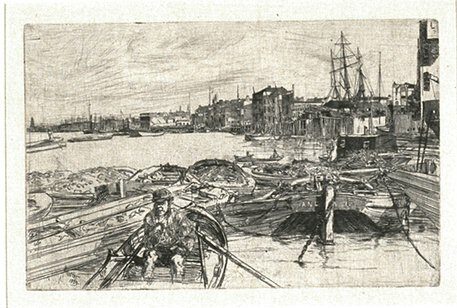The Pool, One of the ‘Sixteen Etchings,’ or the ‘Thames Set’
James Abbott McNeill Whistler

Description
The Pool, from Sixteen Etchings, or the Thames Set
1859
Etching on laid Japan tissue
Undescribed state between third and fourth of four (Kennedy 43)
Bequest of Margaret Watson Parker, 1954/1.337
The Pool of London was the part of the Thames below London Bridge, where ocean-going vessels docked, unloaded, and had their contents inspected and assessed by customs officials. By the second half of the nineteenth century, both of its banks were lined with nearly continuous walls of wharves that ran for miles and hundreds of ships moored in the river or alongside the quays.
The seemingly unvarnished naturalism of Whistler’s etchings of the Thames belies the many influences brought together in them. The controlled linear hatching and contour lines are indebted to the artist’s early mastery of etching at the United States Coast Survey and the topographic maps he produced, while the unusual cropping and tension between surface and depth is the result of his assimilation of Japanese pictorial strategies and the visual effects of early photography. Whistler brilliantly synthesizes these various influences to create a unique and compelling vision of the docksides and shipping along the Thames.
Subject Matter:
In 1859, Whistler spent several months living in Wapping and Rotherthite, creating a number of etchings depicting the bustling commercial docks and warehouses that fringed the Pool of London. These views of modern life represented a departure from traditionally elevated subject matter of art, including scenes from the Bible and ancient history. The French poet Charles Baudelaire had encouraged contemporary artists to find 'the heroism of modern life' in contemporary subjects; when Baudelaire saw these views of London, he lauded Whistler's work as exactly the kind of new approach that he had hoped to inspire in artists.
Physical Description:
A man in a cap sits in a rowboat in the foreground, his chin on his hand looking at the viewer. A number of other boats, all unoccupied, create a barrier between the man and the open expanse of the river that curves towards the left in the distance. The water's edge is congested with wooden buildings and ships, some in dry dock.
Usage Rights:
If you are interested in using an image for a publication, please visit https://umma.umich.edu/request-image/ for more information and to fill out the online Image Rights and Reproductions Request Form.